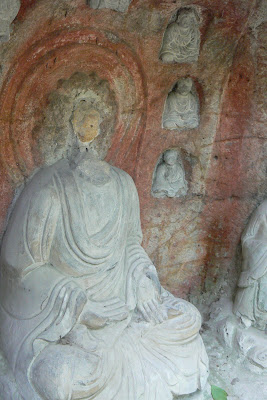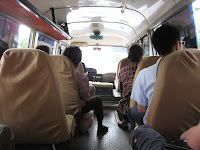 It's not approached quite as casually as ideal - supposedly there's a bus from the train station, but I couldn't find one, and ended up taking a private taxi where we payed 10 kuai ($1.25) apiece for the ride there, with a few strangers - there was no English possible, obviously. It was in an old beat-up mini-mini-van, it took about a minute to get up to speed once we got on the highway.
It's not approached quite as casually as ideal - supposedly there's a bus from the train station, but I couldn't find one, and ended up taking a private taxi where we payed 10 kuai ($1.25) apiece for the ride there, with a few strangers - there was no English possible, obviously. It was in an old beat-up mini-mini-van, it took about a minute to get up to speed once we got on the highway. Once there, we passed by a few bored touts and passed through the gates to get in. The temple occupies a huge, beautiful grounds, it has a large number of Buddhist monks and Buddhist seminary students going about their business - I actually went with some Methodist seminary students. It's a curious mix of the old and the new, and Qixia temple seems to be in the middle of a massive building project. For instance, the pavilion looks old and worn, and is right next to a fountain and a modern-looking Guanyin, riding on a Dragon throne:
Once there, we passed by a few bored touts and passed through the gates to get in. The temple occupies a huge, beautiful grounds, it has a large number of Buddhist monks and Buddhist seminary students going about their business - I actually went with some Methodist seminary students. It's a curious mix of the old and the new, and Qixia temple seems to be in the middle of a massive building project. For instance, the pavilion looks old and worn, and is right next to a fountain and a modern-looking Guanyin, riding on a Dragon throne:
The grounds aren't particularly well marked, but it's a lot of fun just wandering through the paths, they steadily but not particularly steeply make their way uphill.

Things weren't particularly well-marked and I wasn't sure what to expect anyway. I just enjoyed wandering around the forest grounds and seeing what I came across. It's so much fun to chance one's way across a fourteen-hundred year old stone pagoda:

Right next to it are a number of stone Buddhas, carved out of the side of a small cliff. A lot of their heads are smashed in, I assume it's a relic of the Cultural Revolution. I similarly guess that a lot of the construction being done is actually re-building Cultural Revolution damage, but really it's just a guess as I didn't ask anybody about this - next time I'll make a it a point!

Towards the middle heights of the temple complex were the living quarters. The day I visited was the first sunny day in a while, so the laundry was hanging out to dry in force. Which is an inane thing to point out, there's no denying, but it was interesting to see the every-day life of a monk.

Most of what I came across was smaller, though - little pavilions and ponds and vantage points and so forth.

Here a short video of myself turning around in front of the central temple complex. It's about the same as the center of every other Chinese Buddhist temple. The music in the background is Buddhist chant/singing. There's a guy at the end, wearing shorts without a T-shirt! So obviously the dress code is more relaxed than, say, Sikh Temples.
There were massive incense bells, even though the temple wasn't particularly busy. I wonder how busy they'd be if I had gone on the first or the fifteenth of the Chinese calendar, corresponding to the full moon and the half moon. Those are the days that draw the big crowds in, and I imagine that would be the best time to visit.

There's also elephant statues, very interesting. It suggests the strong perceived connection of Buddhism to its native India, although I had never seen Elephants before aside from Jing'an temple. I'm no Buddhism expert, and I'll post if I learn anything more about this.

 Finally, although the bus station was a five or ten minute walk from the temple, we ended up taking a private bus, carrying maybe twenty people. It was interesting, it took a somewhat meandering route back to Nanjing. If the driver saw people walking alongside the road on the way, she offered to give them a ride - we ended up spending a quarter for our ride, once the bus got closer to town the fare dropped down to half of that.
Finally, although the bus station was a five or ten minute walk from the temple, we ended up taking a private bus, carrying maybe twenty people. It was interesting, it took a somewhat meandering route back to Nanjing. If the driver saw people walking alongside the road on the way, she offered to give them a ride - we ended up spending a quarter for our ride, once the bus got closer to town the fare dropped down to half of that.
No comments:
Post a Comment